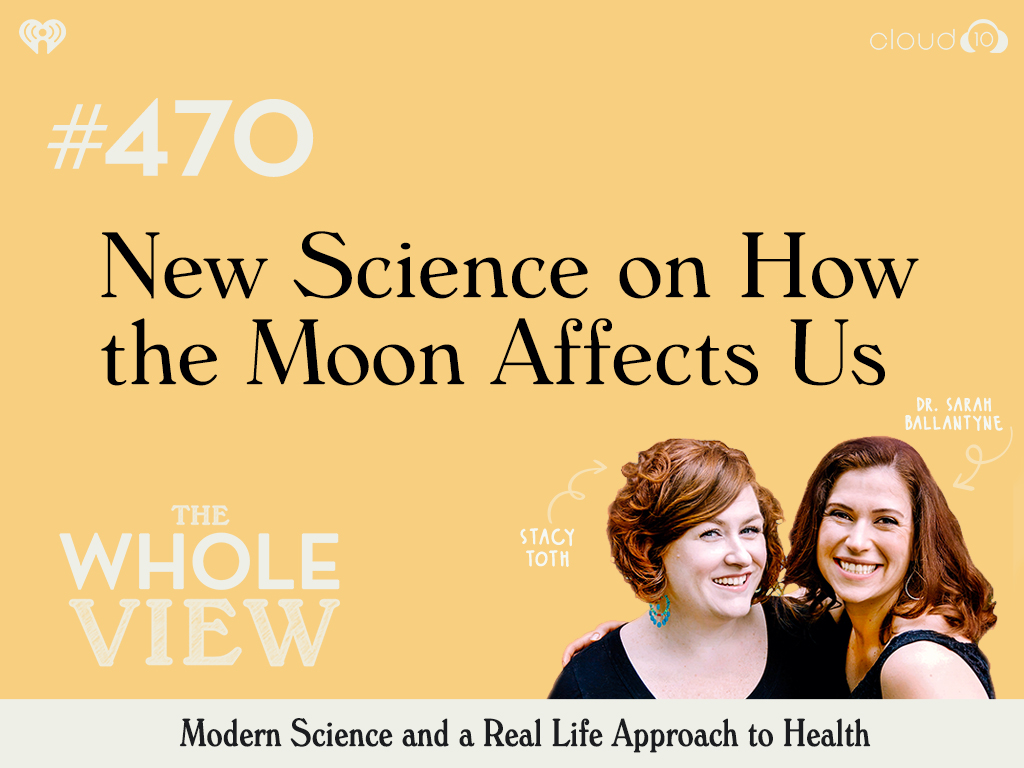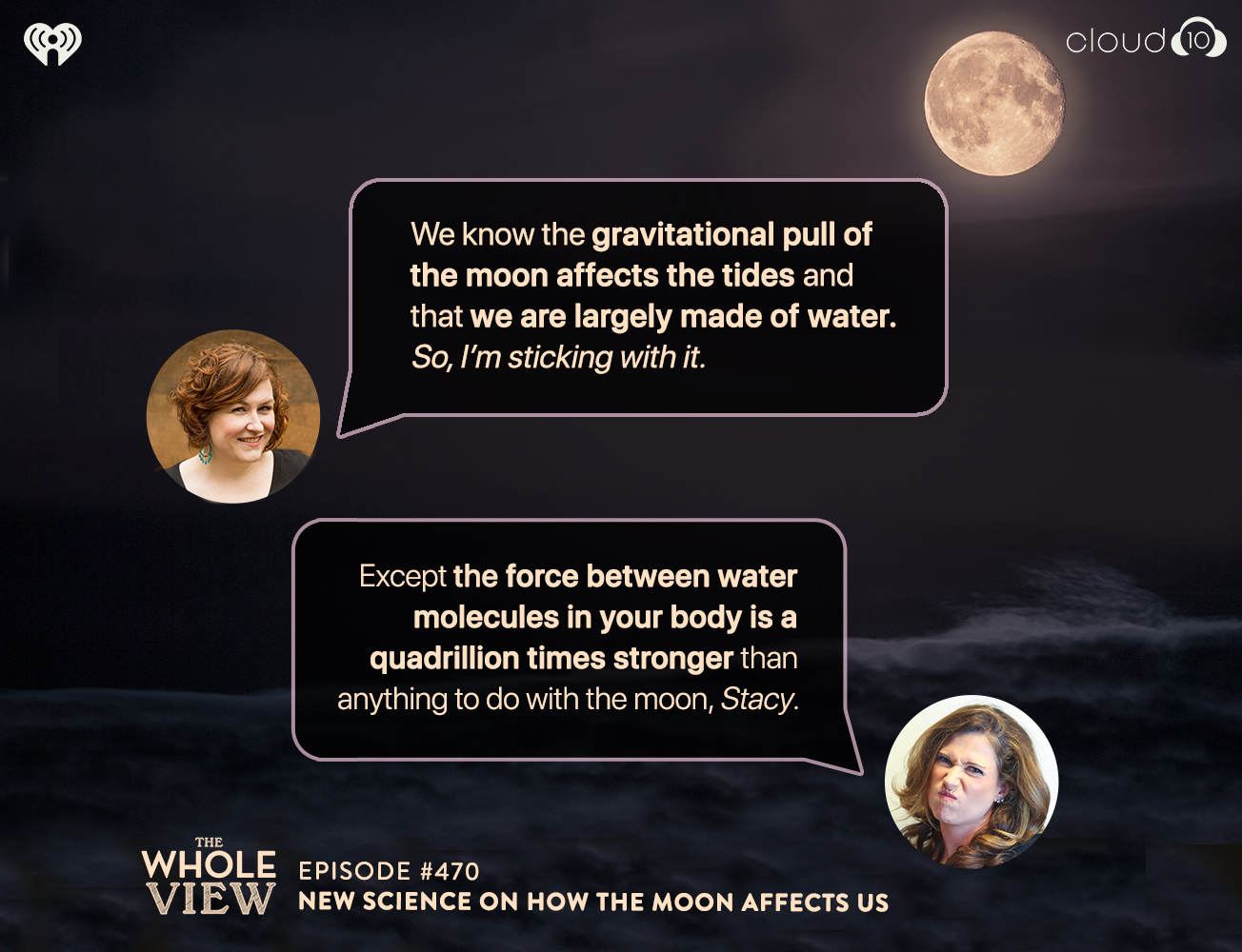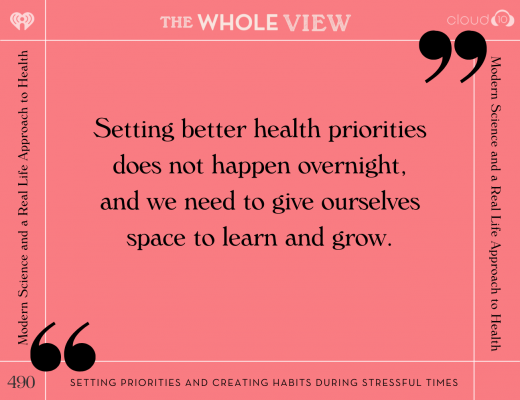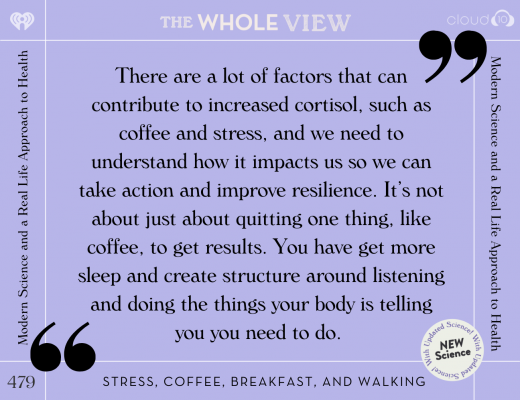
Welcome to episode 470 of The Whole View! This week, Stacy and Dr. Sarah examine new evidence to determine whether or not science can answer the quest whether or not the moon affects us.
If you enjoy the show, please review it on iTunes!
The Whole View, Episode 470: New Science on How the Moon Affects Us
Welcome back to episode 470! (0:28)
To find out what happens when people stop being polite and start getting real, join Stacy and Dr. Sarah on Patreon!
And, it’ll give you access to the Q&A. Stacy and Dr. Sarah will do more, and you don’t want to miss them.
Dr. Sarah went back to the previous show from over three years ago, where they discussed the impact of the lunar cycle on biology (Episode 299: Does the Moon Affect Stacy’s Mood?) and was amused to see the description:
“In this episode, Stacy is convinced that her body and hormones are affected by the moon. What will Sarah say?”
As a brief review, they discussed how marine life is impacted by the lunar cycle. But there’s a lack of evidence for any impact on human biology.
They discussed a handful of studies with conflicting data, no compelling case for the moon impacting us. Stacy didn’t believe it then and still doesn’t believe it now!
Please note Stacy is a science believer, but she also thinks there’s a lot of science that’s still to be discovered. So just because there’s no science to support it yet, it doesn’t mean there couldn’t be in the future.
So per Stacy’s request, let’s look at some recent peer-reviewed studies!
These studies look at three different possible effects of lunar cycles: on sleep, menstrual cycles, and mood cycles in bipolar disease.
Quick Sponsor
Stacy and Sarah use and love JustThrive every day. Stacy actually recommends it to her skincare clients to help with acne, too: that’s how awesome it is! You can get your own discounted at justthrivehealth.com and use code TheWholeView for 15%.
That includes bundles and subscriptions, so definitely double up on your savings. That’s what Stacy did. It’s like buy 2, get 1 bottle free of probiotics every time, and it ships magically to her door!
Sleep: New Science on How the Moon Affects Us
Dr. Sarah touches first on sleep because it’s a factor in a lot of studies. (6:20)
A 2021 study focused on the synchronization of human sleep with the moon cycle under field conditions.
One ground studied was indigenous Toba/Qom communities in Argentina. One group was in an urban setting with full access to electricity. The two others were rural communities- one with access to limited electric light and another with no access to electric light.
Researchers compared these results to 464 University of Washington undergraduate students.
Both the duration and the time of sleep onset showed a clear modulation throughout the moon cycle that was evident in the whole population and the individual communities.
The more access to electricity, the smaller the changes on average from peak to trough.
All communities exhibited cyclicity with the lunar cycle, sleeping the least at full moon and the most at new moon.
Changes in each participant’s sleep duration across the lunar cycle ranged from 20 to more than 90 min and did not differ considerably between groups.
The Why
Is this due to light (the most important zeitgeber) or something more inherent to the moon? Maybe there’s a cultural role?
Interviews with Toba/Qom individuals indicate that moonlit nights are particularly rich in social activities.
Toba/Qom elders report that, at times when they obtained food from the forest, moonlit nights had particularly high hunting and fishing activity.
Furthermore, mythological stories associate the moon with the female reproductive cycle and sexual relations.
The moon in the Toba culture is represented as a man who has sexual relations with women. It induces the first menstruation and regulates the timing of the following menstruations (24).
Interestingly, stories told by elder Toba/Qom point to moonlit nights as nights of higher sexual activity. These latter stories suggest the possibility that ancestrally moonlight-associated encounters could have synchronized reproductive activity with women’s fertility (25).
Context of How The Moon Affects Us
A 2013 posthoc analysis of 64 nights sleep in 33 volunteers sleep study data, found that around a full moon, electroencephalogram (EEG) delta activity during NREM sleep, an indicator of deep sleep, decreased by 30%, time to fall asleep increased by 5 min. In addition, EEG-assessed total sleep duration was reduced by 20 min.
This 2014 also retrospective study in 47 young, healthy volunteers did show less sleep during a full moon.
BUT a 2014 study tried to replicate the results with 3 separate, much larger data sets. They looked at 470 sleep EEGs from 366 volunteers, 757 sleep EEGs of 29 volunteers, each of whom slept for 13–60 consecutive nights in the sleep laboratory, and sleep EEGs of 870 young, healthy volunteers. They couldn’t replicate the effect of lunar cycles on sleep in ANY of the data sets.
Authors suggest previous results were subject to a type of selection bias called the file drawer problem.
File drawer problem: a type of bias when studies fail to reject the null hypothesis (i.e., that do not produce a statistically significant result)
This 2015 study in 795 Danish children did not show significant changes in sleep with the lunar cycle (<4 min difference).
A 2016 study also showed <5 min difference in sleep duration, this time in a large dataset 12 countries, 5,812 kids.
Menstrual Cycles: New Science on How the Moon Affects Us
There are two new studies with information on whether the moon affects menstrual cycles. (16:53)
This 2021 study suggests Women temporarily synchronize their menstrual cycles with the luminance and gravimetric cycles of the moon.
22 women recorded the date their period started for 5 to 32 years with an average of 15 years
Researchers analyzed the relation of menses onset to all three types of the lunar cycle:
- Luminance cycle (aka synodic month) – 29.5 days
- Perigee-apogee cycle (aka anomalistic month) – 27.5 days for orbit
- Lunar standstill cycle (aka tropical month) – 27.3 days, inclination angle
19 of 22 women had their periods align with either the full moon or the new moon every once in a while. This happened a little bit more often than would be expected by chance!
An alternative telling of this story is “evidence shows the women’s cycle aligned with the moon more often than can be scientifically explained otherwise.”
Criticism
Stacy thinks it’s important to note that the study acknowledged the difficulty in tracking this as women’s menstruation cycle changes over time. So, for example, how pregnancy or hormones changing with age affects that percentage (logically makes sense).
The menses of women ≤35 years old synchronized with the full or new moon for an average of 23.6% of the recorded time, while the menses of women >35 years old showed this synchrony for an average of 9.5% of the time.
Considering that menstrual irregularities are estimated to affect between 14-25% of the population, having almost 24% synch with the moon’s cycles is a significant finding for Stacy.
Menses synchronized with the anomalistic or tropical month during 13.1% of the time in women ≤35 years old and 17.7% of the time in records of women >35 years old (Table 1).
The synodic lunar cycle alone does not appear to be a strong zeitgeber because synchronization occurred only intermittently. During any particular period, the women differed in the courses of their menstrual cycles and the timing of synodic synchronization.
The researchers say these findings suggest that both moonlight and the moon’s gravity influence menstruation, although it’s unclear how humans sense these fluctuations.
The study found that synchronization was intermittent and not shared across most women. “It is not a compelling case that biologically meaningful synchrony is occurring.”
An Aside on Probability
The authors iterated their model with different lunar cycle inputs and found the best fit was a binomial distribution with a period of 29.5 days. BUT
They didn’t test the null hypothesis, i.e., how likely is it to have a period aligned on a full moon or new moon if you assume the lunar cycle has no effect.
Full moon plus the new moon, 4 days (one day on either side) out of 29.5 = 13.6% probability for each given day, BUT, this is an overly simplistic way to think about it.
Probability Isn’t Always Intuitive, and with independent vs. dependent studies, probabilities multiply. Not to mention, there’s a birthday problem in probability.
In a group of 23 people, the probability of a shared birthday exceeds 50%, while a group of 70 has a 99.9% chance of a shared birthday.
The Monty Hall Problem highlights that even though some situations feel like there’s a 50/50 chance (which is why most people tend to stick with a first choice), those who switch have a 2/3 chance of winning compared to those who stick to their initial choice with only a 1/3 chance.
Another example is casinos. Psychology has you think you have a better chance of winning than you do, which is why they’re so successful.
On the other hand, Stacy is not shocked that Dr. Sarah can find ways to explain away these findings. What it says to her is “science can’t exactly explain what’s happening,” and that doesn’t mean it’s conclusive or proven wrong.
We’re learning, and that’s super exciting. Seeing a study acknowledge that more women than expected had cycle affected by the moon is very validating. There’s a 2nd study on this, right?
Study #2
A 2021 study looked at The Relationship between the Lunar Phase, Menstrual Cycle Onset and Subjective Sleep Quality among Women of Reproductive Age.
Researchers obtained menstrual cycle onset data from the six most recent menstrual cycles of 529 women (aged 25–39 years) using the smartphone app Luna Luna. They also collected questionnaire survey data on sleep quality from each participant.
There was no association between the onset of the menstrual cycle and the lunar phase. But, when the authors striated by good versus poor sleepers (subjective measurement, not quantitative), they found no statistically significant relationship between lunar phase and sleep quality among participants with a menstrual cycle of 29.5 ± 1 days.
In participants who had longer or shorter cycles, the numbers of menstrual cycle onsets during the light and dark periods were 345 (55%) and 287 (45%) among good sleepers, while 423 (46%) and 504 (54%) were found among poor sleepers.
The authors postulate that lunar impact on sleep is affecting periods because of a physical stressor. BUT this is not a large effect, and it’s a subset of a subset. We could be looking at the file drawer problem again.
It’s hard to accept sleep as a mechanism when the most rigorous studies show no link between the lunar phase and sleep.
Previous Studies On How The Moon Affects Us
A 1974 study of 6,000 cycles found no correlation.
This 1980 study of 312 women showed 68 (21.8%) experienced lunar period cycles (29.5 days), 47 of which had periods in the half of the lunar cycle that is lighter (hardly a full moon effect).
Quote from paper: It is important to realize that the possibility of lunar entrainment of the menstrual cycle is not proven from the data presented.”
In a 1987 study of 822 women followed for 14 weeks (~3 periods), 27% had lunar period cycles.
Of those that had 29.5-day cycles, only 2 out of 5 data sets had a statistically significant increase in periods at full moon. About a third of the women had periods the week of the full moon, but only 5% aligned with a full moon.
This 2013 study in 74 women with 980 menstrual cycles over a calendar year found no correlation with the lunar cycle.
Here’s the thing: if the menstrual cycle length is similar to the length of the lunar cycle, alignment is more likely to happen by chance. This means the null hypothesis HAS to be considered in these papers, and it’s NOT.
Stacy raises the point that we could be asking why menstrual and lunar cycles are the same length, to begin with.
Menstrual Cycle Lengths of Primates
The main evidence seems to be that women’s cycles are a similar amount of time to the lunar cycle and “this can’t possibly be a coincidence.” (39:20)
But, if there’s an evolutionary pressure towards a cycle that aligns with the moon, we’d see this in primates too, right?
What we can see is the times are a little bit more variable than you’d think:
-
- bonobos 32-35 days
- chimpanzees ~37 days
- orangutans cycles are approximately 29 days,
- gorillas 30 – 32 days,
- patas monkey cycles range from 24 – 27 days,
- vervet monkeys from 30 – 31 days,
- mangabeys from 30 – 34 days
- baboons from 30 – 35 days
- Humans menstrual cycle is 28, but it can range from 21 – 35 days
A database of more than 120,000 women indicated that the mean menstrual cycle length was 29.9 ± 5.5 days in 25–29-year-old women.
However, it decreased with increasing age with a mean difference of 2.9 days between the youngest (18–24 years) and oldest (40–45 years) cohorts [10]
This 2021 study found Longitudinal observations call into question the scientific consensus that humans are unaffected by lunar cycles.
The primate argument does not sway Stacy simply because she thinks the universe’s gravitational pull as a whole has some yet determined measurable effect on all living beings.
She does appreciate that Dr. Sarah was at least interested enough to talk about it.
Bipolar Disease: 1 new study + 2 case studies
Stacy admits she is most excited to talk about this last angle of how the moon affects us. (42:05)
This 2017 study looked at bipolar mood cycles and lunar tidal cycles.
In 17 patients with rapid cycling bipolar disorder, time-series analyses detected synchronizes between mood cycles and three lunar cycles that modulate the amplitude of the moon’s semi-diurnal gravimetric tides.
The 14.8-day spring–neap cycle, the 13.7-day declination cycle, and the 206-day cycle of perigee-syzygies (‘supermoons’)
In various patients, at various times, mood cycles exhibited five different modes of resonance with the bi-weekly lunar cycles:
- 1:2 mode in eight patients (Patients 3–5, 7–10 and 12), in which every mood cycle was synchronous with every second bi-weekly lunar cycle (Figures 1, ,2,2, ,4,4, ,5,5, 7, Supplementary Figures S10 and S11).
- 1:3 mode in seven patients (Patients 3, 4, 8–10, 15 and 16), in which every mood cycle was synchronous with every third bi-weekly lunar cycle (Figures 1, ,2,2, ,4,4, ,5,5, ,6,6, ,77 and Supplementary Figure S4).
- 2:3 mode in five patients (Patients 1, 2, 7, 13, and 14), in which every second mood cycle was synchronous with every third bi-weekly lunar cycle (Figures 1, ,22, and and66).
- 1:4 mode in two patients (Patients 6 and 11) in which every mood cycle was synchronous with every fourth bi-weekly lunar cycle (Figures 1 and and2),2), and
- 1:6 mode in one patient (Patient 6), in which every mood cycle was synchronous with every sixth bi-weekly lunar cycle (Figures 1 and and22).
Sarah explains the study established no causality nor attempt to predict the next mood cycle. It’s a small study sample and has many possible patterns.
Stacy’s Rebuttal
Stacy, however, argues that not exactly what it said:
The nature of the mechanism that makes it possible for an object as small as the human body to be affected by the minute changes in gravity that are associated with lunar tidal cycles is unclear and is a question for future research.
As a possible answer, Fisahn and colleagues have developed a model based on a quantum physical approach to the problem30. Although skepticism is warranted, lunar mood cycles may be an experiment of nature that is pointing toward aspects of gravity and biophysics that are only beginning to be investigated.
Scientists hypothesize that human reproductive behavior was synchronous with the moon in ancient times but that our modern lifestyles have changed reproductive physiology and behavior.
Additional Studies on How the Moon Affects Us
A 2018 study looked at bipolar mood cycles associated with lunar entrainment of a circadian rhythm. It looked at analyses of sleep-wake cycles with mood cycles and the lunar cycle.
When the patient adhered to a rigid schedule of rest and sleep during long periods of darkness every night, the lunar signal disappeared, and his mood cycling stopped (Fig. (Fig.33).
Another 2019 studied the Synchrony Between Bipolar Mood Cycles and Lunar Tidal Cycles Ended After Initiation of Light Treatment and Treatment of Hypothyroidism.
This case study involved a 67-year-old woman with rapid-cycling bipolar II disorder on lithium maintenance treatment.
When she was treated with nortriptyline and her thyroid-stimulating hormone levels were elevated, her mood switches had a significant 29- to 30-day periodicity. The analysis showed that the switches were distributed nonrandomly concerning the spring-neap lunar tidal cycle. 14 of 15 switches occurred within 2 days of the spring tides.
After the discontinued use of nortriptyline, thyroid-stimulating hormone levels normalized with treatment with levothyroxine, she started consistent bright light treatment. The synchrony between mood cycles and lunar cycles disappeared. Her rapid cycling eventually stopped.
The possibility that lunar mood cycling is sometimes contingent on antidepressant treatment decreased thyroid function, and certain types of light-dark cycles need to be considered in future research on lunar tidal influences on the course of bipolar illness.
This 2019 study looked at the Commentary on “Synchrony Between Bipolar Mood Cycles and Lunar Tidal Cycles Ended After Initiation of Light Treatment and Treatment of Hypothyroidism.”
Is There A Mechanism?
This 2020 study examined the Molecular Mechanisms of Lunar-Controlled Rhythms and Clocks.
In 2017, another study looked at An Overview of Monthly Rhythms and Clocks.
The mechanism is driven mainly by moonlight (entrenching a circalunar clock gene, for example cry1 and cry2 genes in corals) in marine life, not by tidal or gravitational forces. In mammals, no mechanism has been identified.
In Episode 423: The Scientific Method, Dr. Sarah, and Stacy discussed the different types of studies, statistical power, the importance of mechanistic studies, and how to get to a scientific consensus.
Final Thoughts on How The Moon Affects Us
At this point, there is conflicting data on whether or not the moon affects any aspect of human biology. If there is one, it’s unclear whether or not it’s meaningful.
There’s been no identified mechanism, and papers failing to test a null hypothesis here make Dr. Sarah super skeptical.
She believes absolutely nothing in this data compels me to think the moon has anything more than a negligible and insignificant effect on human biology. But, she’s always happy to see more studies, and maybe eventually one will change her mind.
For Stacy, she believes it’s one step closer than Sarah was before the last studies. As science digs further, we may be able to learn the why of what we’re seeing.
Stacy does know this: her cycle aligns to the moon, and she knows people in her life are directly affected by the moon’s cycles in their moods. Of course, it’s more than a coincidence, but like everything, this is my n=1 until science catches up.
Do you want to hear us hash out what we think and feel about whether or not the moon affects us? Don’t forget to join over on Patreon!





